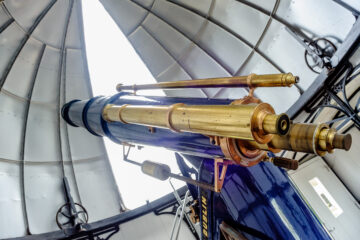JUNE WARMER, WETTER, AND DULLER THAN AVERAGE
Armagh Observatory, 10th July 2025: Armagh Observatory reports that June 2025 was warmer, wetter, and duller than average. With an average temperature of approximately 15.3 degrees Celsius (59.6 Fahrenheit), this was the twelfth warmest June on record at Armagh and the warmest for two years, that is, since the exceptionally warm June 2023 (17.4 C). With 88.0 mm of precipitation it was also the wettest June at Armagh for six years.
The average temperature was approximately 1.9 C warmer than the 225-year long-term (1796–2020) June average at Armagh (13.43 C) and nearly 1.3 C warmer than the most recent (1991–2020) 30-year average (14.05 C). This June continued a trend that has seen a steady increase in recent mean June temperatures at Armagh. Five of the last six Junes have had mean temperatures greater than the most recent (1991–2020) 30-year June average, and over the last forty years the 30-year average June temperatures have increased from 13.55 C to 14.05 C, corresponding to an average increase in mean June temperatures at Armagh of 0.5 C.
This month was remarkable in recording a short-lived heat wave and several very warm nights. Whereas the average daily maximum air temperature was an unexceptional 19.3 C, though still 1.0 C warmer than the corresponding most recent (1991–2020) 30-year average, the average minimum or nighttime air temperature was 11.4 C, approximately 1.5 C warmer than the corresponding most recent 30-year average.
This June, the difference between the average day and nighttime temperatures appears to have been due to clouds, which in the case of a warm, dull month tend to reduce maximum daytime temperatures whilst raising nighttime minima. The average minimum air temperature at Armagh was the third warmest on record, the three warmest such averages now being June 1846 (12.2 C), June 2023 (12.0 C), and June 2025 (11.4 C).
The UK Meteorological Office defines a heat wave in Northern Ireland to be any period of at least three consecutive days when the maximum daily temperature meets or exceeds 25.0 C (77.0 F). This condition was met during the three-day period beginning 19th June 2025. The highest maximum temperature was 29.3 C on the 20th, bounded by 25.4 C on both the 19th and 21st. The 20th is now the warmest day of the year and the seventh warmest June day on record at Armagh. The very warm spell this June was the warmest sequence of June days at Armagh for seven years, that is, since the 27th to the 29th of June 2018, which saw maximum temperatures at Armagh of 30.4 C, 30.2 C, and 29.8 C respectively.
The warmest night, or highest minimum air temperature, was 17.0 on the 30th, followed by 16.4 C on the 21st and 16.1 C on the 28th. The 30th, surpassed by the exceptional 17.2 C recorded on 24th June 2023, was the second warmest night on record at Armagh, shared with the 28th of June 1957.
The coolest day, or lowest maximum air temperature, was the 4th (13.9 C), followed by the 9th (14.4 C) and both the 7th and 8th (14.8 C). The coolest night, or lowest minimum air temperature, was the 6th (5.7 C), followed by the 8th (6.9 C) and the 2nd (7.4 C).
There was just one night with ground frost, that is, a night with a grass-minimumtemperature less than or equal to zero Celsius. This was -1.7 C on the 6th. The following lowest grass-minimum temperatures were 1.4 C on the 2nd and 3.6 C on both the 4th and 5th. There were no night-time air frosts. Thunder was heard on the afternoon of the 6th, and swallows and swifts seen on a number of days.
Total precipitation was 88.0 mm including two trace values, that is, 87.9 mm if trace values are ignored. This is approximately 38% more than the 183-year long-term (1838–2020) June precipitation at Armagh (63.7 mm) and 40% more than the most recent (1991–2020) 30-year June average (62.9 mm). This was the wettest June at Armagh for six years, that is, since 105.1 mm including four trace values was recorded in June 2019.
The wettest day was the 12th with 18.7 mm of rainfall, followed by the 14th with 13.4 mm and the 9th with 11.9 mm. With 134.8 hours of strong sunshine, June 2025 was rather duller than average, approximately 84% of the 140-year long-term (1881–2020) average at Armagh (159.7 hours) and 93% of the most recent (1991–2020) 30-year average (144.6 hours). It is interesting to note that during the first nearly 90 years of the Observatory’s instrumental sunshine record, that is, from 1881 to 1970, the average number of hours of strong sunshine during June was approximately 165 hours, whereas during the subsequent 50 years from 1971 to 2020 it fell sharply to an average of nearly 145 hours, suggesting either an unknown issue with exposure of the sunshine recorder or that Junes at Armagh have become cloudier than, say, a hundred years ago.
This month the sunniest day was the 10th with 10.3 hours of strong sunshine, followed by the 19th with 10.1 hours and the 17th with 9.8 hours.
These data refer to observations at Armagh Observatory, which has been recording the weather at Armagh since 1795.
FOR FURTHER INFORMATION PLEASE CONTACT: Mark Bailey at the Armagh
Observatory, College Hill, Armagh, BT61 9DG. Tel.: 028-3752-2928;
mark.bailey@armagh.ac.uk; URL: http://climate.armagh.ac.uk/






0 Comments